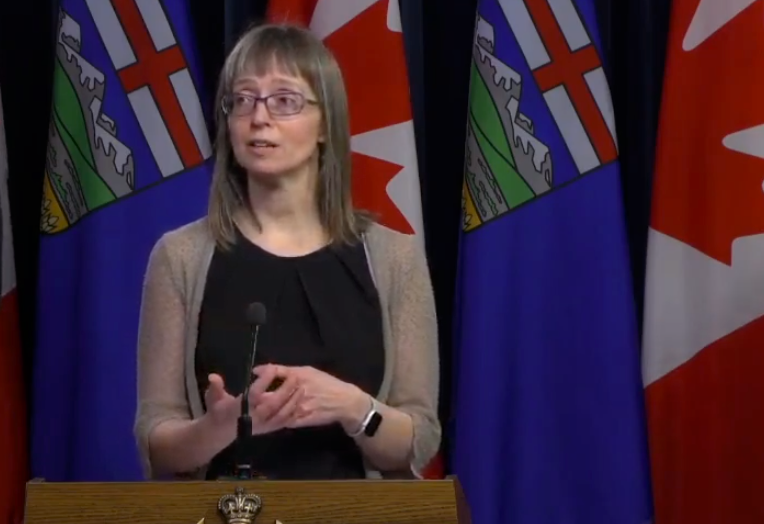ALBERTA – Preparing for the peak of COVID-19 pandemic in Alberta, the province announced it is taking steps to ensure the health care system is not overwhelmed.
Alberta's Chief Medical Officer of Health Dr. Deena Hinshaw said Thursday (March 26) the coming weeks will prove difficult as the virus continues to transform day-to-day life in the province.
“I want Albertans to understand there will be challenges coming in the next weeks,” Hinshaw said.
“We have all seen what has occurred in countries like Italy and Spain. We are doing everything possible to prevent that from happening in Alberta by limiting the number of people who will need hospital care by preventing the spread of this virus.”
Hinshaw reported there were 67 new cases of COVID-19 in the province, 34 of which are likely the result of community transmission. Of these cases, 21 people have been hospitalized and 10 are receiving treatment in intensive care units.
There have been five cases reported in the Canmore region.
A reported 27 people have recovered from the virus since the first case in Alberta was reported three weeks ago.
There have been 486 cases documented in the province, this number includes those that have recovered from the virus.
The Alberta health care system will be challenged in the coming weeks as the number of COVID-19 virus cases climbs, Hinshaw said, warning that many difficult decisions may be made in the coming days.
“To date, our health system has responded remarkably to that test,” Hinshaw said, commending the work of health care workers in the province.
“The health system is preparing for every possible scenario in the days ahead.”
Actions are required now, Hinshaw said, to ensure that health care workers are not overwhelmed in the future.
In preparation for the peak of the virus, Alberta Health Services is exploring options to ensure there will be the space, resources and health care workers available for Albertans who require care, said Dr. Mark Joffe, vice-president and medical director for northern Alberta.
“Alberta Health Services staff and physicians have been working feverishly for a number of weeks now to plan for the space that we are going to need,” Joffe said.
There are approximately 8,500 hospital beds in the province and Alberta Health Services is planning for a need of approximately 2,250 of these beds for COVID-19 patients.
Steps have already been taken to ensure these spaces are available, Joffe said, citing the cancellation of elective surgeries in the province as an example.
“At the same time, we know we need to find additional beds. Our teams are doing exactly that – looking for care spaces,” Joffe said.
“The entire community will be part of this response.”
He added that because AHS is able to work as an integrated health system there is the possibility patients may be relocated to ensure they receive proper care.
To help prevent the spread of the virus to the province's most vulnerable demographics, Hinshaw said an online assessment tool for health care workers will soon be available. She added the survey was developed for health care workers because they are most at risk of exposure to COVID-19.
Any workers experiencing symptoms of cough, fever, runny nose, sore throat, shortness of breath, or difficulty breathing, can access the online assessment at ahs.ca/covid.
The assessment tool will launch Friday morning (March 27) and is in addition to the online assessment available to the public.
Hinshaw said a major challenge in evaluating the reach of the virus lies in the fact it comes from two sources – those who have returned to Canada from outside the country and community transmissions.
The goal with the current measures that have been put in place is to prevent community transmission of the virus, she said. The impacts of these measures to minimize community spread will hopefully result in the continuation of flattening the curve for the health care system.
Hinshaw said given there are 33 cases where it is unclear where COVID-19 was acquired it appears that there are cases in the province that have not been detected.
“Those 33 cases are the tip of the iceberg,” Hinshaw said.
“There are other people we have not detected who are in the community who have spread the disease, and there may be others who are continuing to spread it.”
It is imperative to be cautious when looking at the number of positive COVID-19 cases, Hinshaw said, because in only represents a portion of those who are infected and have been identified.
Hinshaw cautioned Albertans to take care and follow health measures because there is no vaccine or treatments for COVID-19.
“I continue to remind Albertans that their decisions, our decisions will impact our health and the health of everyone around us,” Hinshaw said. “We don’t need a rule or an order to make practical adjustments in our daily life to limit the risk for ourselves and our loved ones.”
Follow RMOToday.com's COVID-19 special section for the latest local and national news on the coronavirus pandemic, as well as resources, FAQs and more.







